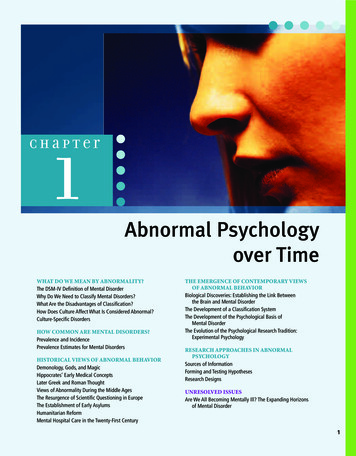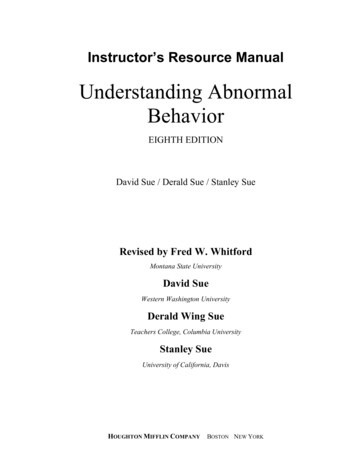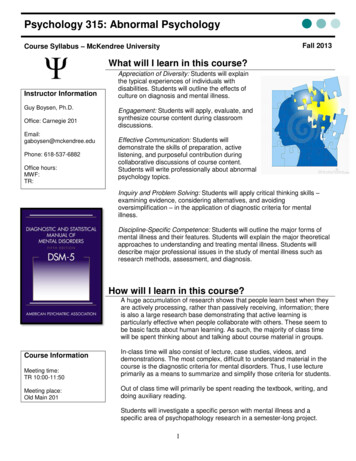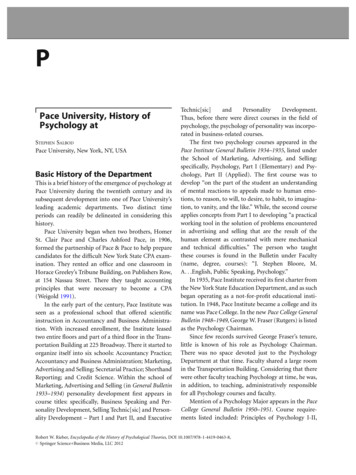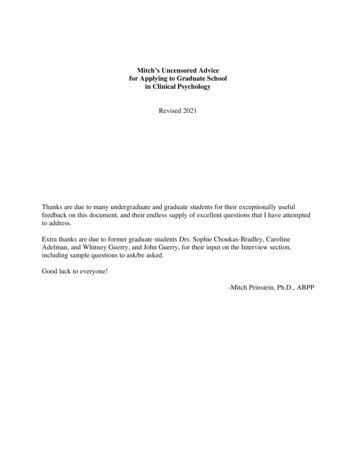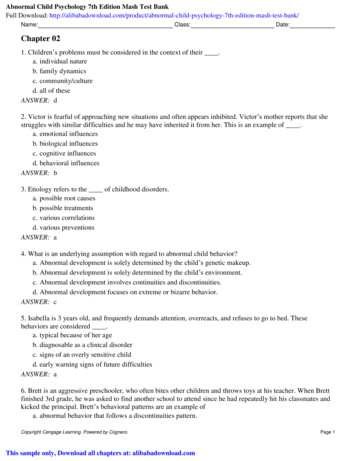
Transcription
Abnormal Child Psychology 7th Edition Mash Test BankFull Download: ate:Chapter 021. Children’s problems must be considered in the context of their .a. individual natureb. family dynamicsc. community/cultured. all of theseANSWER: d2. Victor is fearful of approaching new situations and often appears inhibited. Victor’s mother reports that shestruggles with similar difficulties and he may have inherited it from her. This is an example of .a. emotional influencesb. biological influencesc. cognitive influencesd. behavioral influencesANSWER: b3. Etiology refers to the of childhood disorders.a. possible root causesb. possible treatmentsc. various correlationsd. various preventionsANSWER: a4. What is an underlying assumption with regard to abnormal child behavior?a. Abnormal development is solely determined by the child’s genetic makeup.b. Abnormal development is solely determined by the child’s environment.c. Abnormal development involves continuities and discontinuities.d. Abnormal development focuses on extreme or bizarre behavior.ANSWER: c5. Isabella is 3 years old, and frequently demands attention, overreacts, and refuses to go to bed. Thesebehaviors are considered .a. typical because of her ageb. diagnosable as a clinical disorderc. signs of an overly sensitive childd. early warning signs of future difficultiesANSWER: a6. Brett is an aggressive preschooler, who often bites other children and throws toys at his teacher. When Brettfinished 3rd grade, he was asked to find another school to attend since he had repeatedly hit his classmates andkicked the principal. Brett’s behavioral patterns are an example ofa. abnormal behavior that follows a discontinuities pattern.Copyright Cengage Learning. Powered by Cognero.This sample only, Download all chapters at: alibabadownload.comPage 1
Name:Class:Date:Chapter 02b. abnormal behavior that follows a continuity pattern.c. normal age appropriate development.d. sociopathic behavior that is rare in young children.ANSWER: b7. When developmental psychopathologists view adaptive and maladaptive behaviors as the result of previousinteractions and experiences spread over several years, they refer to the process asa. typical development.b. environmental determinants.c. developmental cascades.d. developmental theoretics.ANSWER: c8. An integrative approach to the psychopathology of a child means thata. maladaptive behaviors are acceptable.b. all development takes place on a continuum.c. more than one therapist has to see the child.d. many theories and concepts can be used to explain behavior.ANSWER: d9. Most often, adaptational failure is due to a(n) .a. single, definable causeb. longstanding biological maladaptationc. ongoing interaction between the individual and environmentd. sudden onset of an environmental challengeANSWER: c10. A toddler learning to make sounds such as “mememe” and “bagabaga” before learning how to useintelligible language indicates a structure and process to development, otherwise known as thea. organization of development.b. hierarchy of development.c. biological perspective.d. integrative perspective.ANSWER: c11. The windows of time during which environmental influences on development are enhanced are called .a. sensitive periodsb. critical periodsc. crucial periodsd. necessary periodsANSWER: aCopyright Cengage Learning. Powered by Cognero.Page 2
Name:Class:Date:Chapter 0212. , The brain develops and grows over a lifetime, but from birth to 11 years, the most dramatic changesoccur. Problems or disruptions that occur when a child is young can lead toa. disorganized development.b. organic disorders.c. hierarchical development.d. broken synapses.ANSWER: b13. Children’s development occurs in a(n) manner.a. mostly randomb. strictly organizedc. strictly hierarchicald. organized and hierarchicalANSWER: d14. The developmental psychopathology approach to studying childhood disorders emphasizes the importanceof developmental .a. disruptionsb. processes and tasksc. regressionsd. obstaclesANSWER: b15. The two terms that are used to explain how a child’s interaction with his/her environment can lead to thedevelopment of maladaptive behaviors area. organized and interactiveb. interactive and proactivec. transaction and interdependentd. transaction and transitionANSWER: d16. The role that a child’s primary caretaker has in terms of that child’s brain development is crucial, sincethose early experiences form the part of the brain that is responsible for their .a. planning and complex processesb. Problem-solving skillsc. emotion, personality, and behaviord. Fine and gross motor skillsANSWER: c17. Brain maturity occurs in a(n) fashion.a. mostly randomCopyright Cengage Learning. Powered by Cognero.Page 3
Name:Class:Date:Chapter 02b. strictly organizedc. strictly hierarchicald. organized and hierarchicalANSWER: d18. Which statement about neural development is false?a. Most developing axons reach their destination even before a baby is born.b. Synapses both proliferate and disappear in early childhood.c. Brain connections are relatively predetermined and cannot be changed by the environment.d. Primitive areas of the brain develop first.ANSWER: c19. Which statement about neural development is true?a. Major restructuring of the brain in relation to puberty occurs between 6 and 9 years of age.b. The brain stops developing after 3 years of age.c. Primitive areas of the brain mature last.d. The prefrontal cortex and the cerebellum are not wired until a person is 5 to 7 years old.ANSWER: d20. Which statement about our genetic makeup is false?a. Genes determine behavior.b. Genes are composed of DNA.c. Genes produce proteins.d. The expression of genes is influenced by the environment.ANSWER: a21. The problem with family aggregation studies is that they .a. are difficult to carry outb. do not control for environmental variablesc. only tell us about the influence of the environmentd. only tell us about chromosomal abnormalitiesANSWER: b22. Molecular geneticists focus on finding a specific gene for childhood disorder, while behavioral geneticists.a. study the possible connection between genetic predisposition and behaviorb. study the possible connection between genes and educationc. focus on brain development between 3 and 5 yearsd. focus on neural synapsis developing until age 11ANSWER: cCopyright Cengage Learning. Powered by Cognero.Page 4
Name:Class:Date:Chapter 0223. Which part of the brain is most responsible for regulating our emotional experiences, expressions, andimpulses?a. Hypothalamusb. Hindbrainc. Basal gangliad. Limbic systemANSWER: d24. Epinephrine is also known as .a. dopamineb. serotoninc. cortisold. adrenalineANSWER: d25. Which part of the brain is implicated in disorders affecting motor behavior?a. Hypothalamusb. Hindbrainc. Basal gangliad. Limbic systemANSWER: c26. The gives us the distinct qualities that make us human and allows us to think about the future, to beplayful, and to be creative.a. cerebral cortexb. limbic systemc. brainstemd. hippocampusANSWER: a27. The lobes contain the functions underlying much of our thinking and reasoning abilities.a. temporalb. frontalc. parietald. occipitalANSWER: b28. The gland produces epinephrine in response to stress.a. hypothalamusb. thyroidc. adrenalCopyright Cengage Learning. Powered by Cognero.Page 5
Name:Class:Date:Chapter 02d. pituitaryANSWER: c29. Mike is having a very difficult time in school. Which gland would produce epinephrine in response to thestress he is experiencing?a. Hypothalamusb. Cortisolc. Adrenald. TegmentumANSWER: b30. Cindy has recently been diagnosed with anorexia. From a biological perspective, which neurotransmitterplays a role in eating disorders?a. GABAb. Serotoninc. Dopamined. PituitaryANSWER: b31. The gland oversees the body’s regulatory functions by producing several hormones, including estrogenand testosterone.a. pinealb. pituitaryc. thyroidd. adrenalANSWER: b32. has been implicated in several psychological disorders, especially those connected to a person’sresponse to stress and ability to regulate emotions.a. The HPA axisb. BZ-GABAc. Norepinephrined. DopamineANSWER: a33. What is an inhibitory neurotransmitter that reduces overall arousal and levels of anger, hostility, andaggression?a. Serotoninb. Benzodiazepine-GABAc. Norepinephrined. DopamineCopyright Cengage Learning. Powered by Cognero.Page 6
Name:Class:Date:Chapter 02ANSWER: b34. acts like a “switch” in the brain, turning on various circuits associated with certain types of behavior.a. Serotoninb. Benzodiazepine-GABAc. Norepinephrined. DopamineANSWER: d35. The neurotransmitter implicated in regulatory problems, such as eating and sleep disorders, is .a. norepinephrineb. serotoninc. benzodiazepine-GABAd. dopamineANSWER: b36. The child-caregiver role helps children explore their own emotions. Which style of parenting allows for thehealthiest development of the child?a. Restrictiveb. Demandingc. Emotionald. AuthoritativeANSWER: d37. ACTH causes the adrenal glands to release .a. benzodiazepine-GABAb. cortisolc. serotonind. dopamineANSWER: b38. James often appears to be in a bad mood and he is easily frustrated when given challenging tasks. Histemperament would be described as .a. angry and intenseb. negative affect or irritabilityc. fearful or inhibitedd. positive affect and approachANSWER: b39. Kim had been physically abused when she was 5, and is now a 10-year-old showing signs of “numbing,”which is an emotional dysregulation. In Kim’s situation, is her behaviorCopyright Cengage Learning. Powered by Cognero.Page 7
Name:Class:Date:Chapter 02a. completely maladaptive and in need of change?b. adaptive and protective?c. maladaptive and will lead to a personality disorder?d. adaptive and should not be changed?ANSWER: b40. A child who cannot control his temper has problems in emotion .a. sensitivityb. reactivityc. regulationd. deregulationANSWER: c41. relates to how children think about themselves and others, resulting in mental representations ofthemselves, relationships, and their social world.a. Social cognitionb. Observational learningc. Cognitive mediationd. Cognitive developmentANSWER: a42. Individual differences in emotion account for differing responses to a stressful environment.a. affectivityb. sensitivityc. reactivityd. regulationANSWER: c43. problems refer to weak or absent control structures, whereas problems indicate that existingcontrol structures operative in a maladaptive way.a. Regulation; dysregulationb. Dysregulation; regulationc. Reactivity; regulationd. Regulation; reactivityANSWER: a44. Temperament .a. refers to a child’s unpredictable behaviorb. shapes a child’s approach to the environment and vice versac. is not related to personalityd. forms very late in developmentCopyright Cengage Learning. Powered by Cognero.Page 8
Name:Class:Date:Chapter 02ANSWER: b45. Brendan is considered by his caregivers as a “slow-to-warm-up child,” who is cautious in approaching novelor challenging situations. Which of the following would describe Brendan’s temperament?a. Positive affect and approachb. Fearful or inhibitedc. Negative affect or irritabilityd. Adaptive with negative moodANSWER: b46. Sharon is a psychologist who is using the ABA method with her client Katie, a difficult 6-year-old. As anABA therapist, Sharon would focus ona. behavior only.b. antecedents and consequences only.c. behavior and consequences only.d. behavior, antecedents, and consequences.ANSWER: d47. explain the acquisition of problem behavior on the basis of paired associations between previouslyneutral stimuli (e.g., homework), and unconditioned stimuli (e.g., parental anger).a. Operant modelsb. Classical conditioning modelsc. Social learning modelsd. Social cognition modelsANSWER: b48. theorists emphasize attributional biases, modeling, and cognitions in their explanation of abnormalbehavior.a. Behaviorb. Psychodynamicc. Social learningd. BiologicalANSWER: c49. models portray the child’s environment as a series of nested and interconnected structures.a. Environmentalb. Ecologicalc. Societald. MacroparadigmANSWER: b50. John Bowlby’s research on attachment showed that a child who has a secure attachment with a caregiverCopyright Cengage Learning. Powered by Cognero.Page 9
Name:Class:Date:Chapter 02generally leads toa. atypical development.b. extra neurotransmitters being released.c. the development of a child’s positive internal working model.d. an unknown outcome, since that attachment is broken after 12 months of age.ANSWER: c51. Attachment theory considers crying (in an infant) to be a behavior that .a. serves to keep predators awayb. stimulates the immune systemc. irritates othersd. enhances relationships with the caregiverANSWER: d52. According to Bronfenberger’s ecological model of environmental influences, which influence plays a role inthe child’s life?a. Church or synagogueb. Neighborhood play areasc. Mass mediad. All of the aboveANSWER: d53. The process of attachment typically begins between of age.a. 0 to 2 monthsb. 6 to 12 monthsc. 12 to 18 monthsd. 18 to 24 monthsANSWER: b54. Infants that explore the environment with little affective interaction with the caregiver are likely to have a(n)attachment pattern.a. secureb. anxious-avoidantc. anxious-resistantd. disorganizedANSWER: b55. Jace is a baby that often seems nervous in new situations and around new people and is not easily comfortedby his mother in these situations. Jace most likely has which attachment pattern?a. Secureb. Anxious-avoidantCopyright Cengage Learning. Powered by Cognero.Page 10
Name:Class:Date:Chapter 02c. Anxious-resistantd. DisorganizedANSWER: c56. Luca has been showing aggressive behavior with his peers and has difficulty conducting himself in a normalfashion, and is constantly getting in trouble at school. According to attachment theories, which type ofattachment pattern did Luca most likely exhibit as a child?a. Secureb. Anxious-avoidantc. Anxious-resistantd. DisorganizedANSWER: b57. Which attachment pattern has been linked to phobias and anxiety problems?a. Secureb. Anxious-avoidantc. Anxious-resistantd. DisorganizedANSWER: c58. Which term describes a child’s model of relationships in terms of what the child expects from others andhow the child relates to others?a. Internal working modelb. External working modelc. Internal attachment modeld. External attachment modelANSWER: a59. theorists argue that a child’s behavior can only be understood in terms of relationships with others.a. Cognitiveb. Behavioralc. Family systemsd. GeneticANSWER: c60. The view of child development recognizes the importance of balancing the abilities of individualswith the challenges and risks of their environments.a. health promotionb. family systemsc. attachmentd. psychopathologicalCopyright Cengage Learning. Powered by Cognero.Page 11
Name:Class:Date:Chapter 02ANSWER: a61. Discuss the three major underlying assumptions regarding abnormal child behavior.ANSWER: The first underlying assumption is that abnormal child behavior is multiply determined. Thus, we have tolook beyond the child’s current symptoms and consider developmental pathways and interacting events that,over time, contribute to the expression of a particular disorder. The second assumption extends the influenceof multiple causes by stressing how the child and environment are interdependent—how they influence eachother. This concept departs from the tradition of viewing the environment as acting on the child to causechanges in development, and instead argues that children also influence their own environment. In simpleterms, the concept of interdependence appreciates how nature and nurture work together and are, in fact,interconnected. Few psychological disorders or impairments suddenly emerge without at least some warningsigns or connections to earlier developmental issues. This connection is apparent, for example, in early-onsetand persistent conduct disorders, with which parents and other adults often see troublesome behaviors at ayoung age that continue in some form into adolescence and adulthood.62. Distinguish between continuous and discontinuous patterns of behavior development. Which category would aneating disorder fall? Which category would persistent conduct disorders fall?ANSWER: Continuity implies that developmental changes are gradual and quantitative (i.e., expressed as amounts thatcan be measured numerically, such as weight and height changes) and that future behavior patterns can bepredicted from earlier patterns. Discontinuity, in contrast, implies that developmental changes are abrupt andqualitative (i.e., expressed as qualities that cannot be measured numerically, such as changes in mood orexpression) and that future behavior is poorly predicted by earlier patterns.An eating disorder isdiscontinuous. Persistent conduct disorder is continuous63. What is meant by using an integrative approach to understanding factors that influence a child’s behavior?ANSWER: Because no single theoretical orientation can explain various behaviors or disorders, we must be familiar withmany theories and conceptual models—each contributes important insights into normal and abnormaldevelopment.64. Most children follow a predictable pattern of development in terms of walking, talking, learning, and so on.Additionally most clinical disorders commonly appear at predictable points in development. For the following ages, listtwo common clinical disorders: 0–2, 2–5, and 6–11.ANSWER: 0–2: mental retardation and autism; 2–5: speech and language disorders, anxiety, and problems stemmingfrom child abuse and neglect; 6–11: ADHD and learning disorders.65. How can a baby with a difficult temperament influence and be influenced by the environment?ANSWER: This dimension describes the “difficult child,” who is predominantly negative or intense in mood, not veryadaptable, and arrhythmic. Some children with this temperament show distress when faced with novel orchallenging situations, and others are prone to general distress or irritability, including when limitations areplaced on them.66. Discuss how children learn from their emotions and the emotional expression of others.ANSWER: Children have a natural tendency to attend to emotional cues from others, which helps them learn to interpretand regulate their own emotions. They learn, from a very young age, through the emotional expressions ofothers.67. How permanent are early neuronal connections?ANSWER: This question has provoked different theories and agonized many parents who are concerned about theirCopyright Cengage Learning. Powered by Cognero.Page 12
Name:Class:Date:Chapter 02children’s early development. For instance, if early brain functions are unlikely to change, this implies thatearly experiences set the course for lifetime development. Freud’s similar contention implied that anindividual’s core personality is formed from an early age, which sets the pace and boundaries for furtherpersonality formation.68. Discuss the major functions of four major neurotransmitters in the brain and their implicated role in psychopathology.ANSWER: Benzodiazepine-GABA reduces arousal and moderates emotional responses, such as anger and hostility; it isimplicated in anxiety disorder. Dopamine may act as a switch that turns on various brain circuits, allowingother neurotransmitters to inhibit or facilitate emotions or behavior and is implicated in schizophrenia, mooddisorders, and attention-deficit/hyperactivity disorder. Norepinephrine facilitates or controls emergencyreactions and alarm responses; it plays a role in emotional and behavioral regulation, but is not directlyimplicated with any specific disorder. Serotonin plays a role in information and motor coordination, and isimplicated in regulatory problems, obsessive-compulsive disorder, schizophrenia, and mood disorders.69. Caspi (2003) conducted a study that connected early temperament style in children, and their personality traits asadults. Is this study practically helpful in terms of what we can do, if anything, to prevent a difficult child with self-controlissues from being a difficult adult with self-control issues?ANSWER: Yes.70. Distinguish between emotion reactivity and emotion regulation.ANSWER: Emotion reactivity refers to individual differences in the threshold and intensity of emotional experience,which provide clues to an individual’s level of distress and sensitivity to the environment. Emotionregulation, on the other hand, involves enhancing, maintaining, or inhibiting emotional arousal, which isusually done for a specific purpose or goal.71. Briefly describe the three primary dimensions of temperament.ANSWER: Positive affect and approach. This dimension describes the “easy child,” who is generally approachable andadaptive to his or her environment and possesses the ability to regulate basic functions of eating, sleeping,and elimination relatively smoothly.Fearful or inhibited. This dimension describes the “slow-to-warm-up child,” who is cautious in his or herapproach to novel or challenging situations. Such children are more variable in self-regulation andadaptability and may show distress or negativity toward some situations.Negative affect or irritability. This dimension describes the “difficult child,” who is predominantly negative orintense in mood, not very adaptable, and arrhythmic. Some children with this temperament show distresswhen faced with novel or challenging situations, and others are prone to general distress or irritability,including when limitations are placed on them.72. Provide everyday examples of positive and negative reinforcement, extinction, and punishment.ANSWER: An example of positive reinforcement would be a mother giving a child a special treat if the child behaved inthe store. Negative reinforcement would occur when you get in your car and buckle your seatbelt in order tostop the beeping noise. If I got sick on a certain food and was then conditioned to avoid it because it causednausea, extinction would occur when I no longer pair the sickness with the food and can eat it again. Positivepunishment is an active process—doing something to someone like assigning extra chores.73. Explain why an integrative approach is important in abnormal psychology.ANSWER: Each model is restricted in its ability to explain abnormal behavior to the extent that it fails to incorporateimportant components of other models. Fortunately, such disciplinary boundaries are gradually diminishingas different perspectives take into account important variables derived from other models. Over time, majortheories of abnormal child psychology have become compatible with one another. Rather than offeringCopyright Cengage Learning. Powered by Cognero.Page 13
Abnormal Child Psychology 7th Edition Mash Test BankFull Download: ate:Chapter 02contradictory views, each theory contributes one or more pieces of the puzzle of atypical development. As allthe available pieces are assembled, the picture of a particular child or adolescent disorder becomes more andmore distinct.74. Discuss the main principles of a developmental psychopathology perspective.ANSWER: Developmental psychopathology is an approach to describing and studying disorders of childhood,adolescence, and beyond in a manner that emphasizes the importance of developmental processes and tasks.This approach provides a useful framework for organizing the study of abnormal child psychology aroundmilestones and sequences in physical, cognitive, social–emotional, and educational development. It also usesabnormal development to inform normal development, and vice versa (Cicchetti, 2006; Hinshaw, 2013).Simply stated, developmental psychopathology emphasizes the role of developmental processes, theimportance of context, and the influence of multiple and interacting events in shaping adaptive andmaladaptive development. We adopt this perspective as an organizing framework to describe the dynamic,multidimensional process leading to normal or abnormal outcomes in development.75. Why do family systems theorists stress the importance of looking at the whole family as opposed to one individual’sdifficulties?ANSWER: This view is in line with our earlier discussion of underlying assumptions about children’s abnormaldevelopment—relationships, not individual children or teens, are often the crucial focus.Copyright Cengage Learning. Powered by Cognero.This sample only, Download all chapters at: alibabadownload.comPage 14
4. What is an underlying assumption with regard to abnormal child behavior? a. Abnormal development is solely determined by the child’sgenetic makeup. b. Abnormal development is solely determined by the child’senvironment. c. Abnormal development involves continuities and discontinuities. d.
